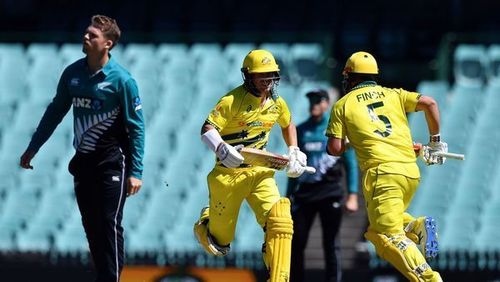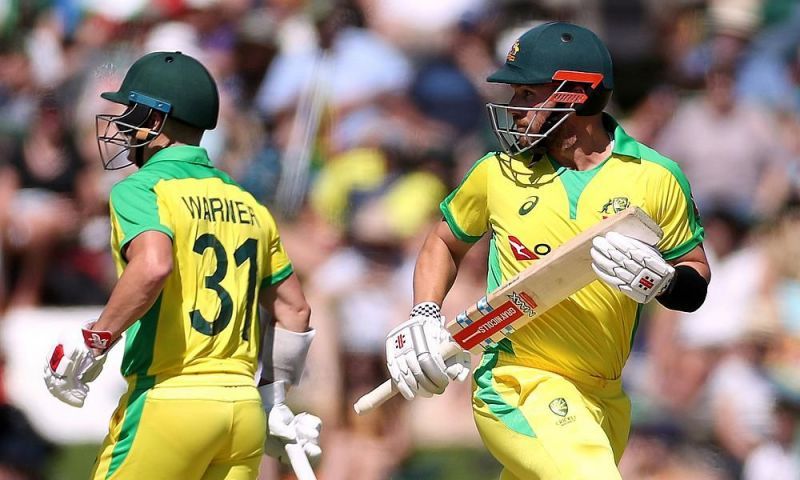
Australia vs New Zealand 2020 | Chappell-Hadlee Trophy: 3 reasons why the Aussies won the first ODI

Australia registered a comfortable 71-run victory against New Zealand in the 1st ODI at Sydney, taking a 1-0 lead in the 3-match series.
Opting to bat first on a pitch which was expected to slow down in the latter half, Australia had a formidable opening stand of 124 runs. However, the departure of Aaron Finch (60), Steven Smith (14) and D'Arcy Short (5) reduced Australia from 145-1 to 165-4, giving the visitors an opportunity to bounce back into the match. But New Zealand could not make much of that chance as Australia's Marnus Labuschagne (56) and Mitchell Marsh (27) helped the score to reach 258-7 in 50 overs with their gritty batting.
In reply, the New Zealand batsmen fell in front of the Australian bowlers as they kept losing wickets at regular intervals. Apart from Martin Guptill's 73-ball 40, none of the top order batsmen could contribute with significant scores. Later, Tom Latham (38) and Colin de Grandhomme (25) tried to rescue the New Zealand innings with a 51-run stand for the sixth wicket. But with their departure, New Zealand lost their slight chances of winning the match and eventually got bundled out for 187 runs in 41 overs. For Australia, Pat Cummins (3/25) and Mitchell Marsh (3/29) were the pick of the bowlers, scalping 3 wickets apiece.
The match was played behind closed doors in an attempt to prevent the spread of the coronavirus at Sydney Cricket Ground. But that did not stop the players from giving their best to be a reason for their team's victory. And on that note, let's have a look at the three reasons for Australia's triumph over the visitors in the 1st ODI.
#1 The century opening stand between David Warner and Aaron Finch

After winning the toss, the Australian openers David Warner (67 runs off 88 balls) and Aaron Finch (60 runs off 75 balls) shouldered the responsibility to provide their team a solid start. The duo carefully started the innings and steadily took it forward, countering the New Zealand bowling attack well. Thanks to their sensible batting, Australia put 50 runs on the board in the first 10 overs.
The 'Warner-Finch' show continued as both the batsmen continued to deny the New Zealand bowlers their wickets. The scoring rate was not at par for such an aggressive pair, but keeping the scoreboard ticking with occasional boundaries did the trick and Australia were 100-0 at the end of the 19th over.
The partnership was broken in the 25th over of the Australian innings when Lockie Ferguson (2/60) sent Warner back to the pavilion. Although New Zealand had something to cheer about with the wicket of Warner, the 124-run stand already set the platform for a big total to challenge the visitors in the match.
#2 The rescue mission of Labuschagne and Marsh after the mini-collapse

Australia were 127-1 at the end of 25 overs and with the century-stand between the openers were looking to post a competitive total. However, the wicket of Finch in the 29th over turned the tables around and allowed New Zealand to get onto the driver's seat. The tight bowling by Mitchell Santner (2/34) and Ish Sodhi (3/51) in the middle overs awarded them with the wickets of Finch, Steven Smith and D'Arcy Short for just 20 runs, pushing the hosts to the backfoot with a score of 165-4 in 34.3 overs.
But the partnership between Labuschagne (56 runs off 52 balls) and Marsh (27 runs off 34 balls) for the fifth wicket stood as a barrier in front of the New Zealand bowlers from getting further success. The 59-run stand between the two put the Australian innings back on the track and helped to reach a respectable position.
Marsh departed in the 46th over, but Labuschagne continued to play his role and took Australia's score to 258-7 in 50 overs, which was enough to defend on a track which got progressively slower with the match.
#3 A bowling unit which delivered in the match

New Zealand did well to restrict Australia to 258-7 after that century-stand between their openers. And while chasing the target of 259, they needed their batsmen to step up and face the Australian bowlers. However, the visitor's batting line-up could not survive in front of a spirited Australian bowling unit as the bowlers sent back the New Zealand batsmen one after another before they could settle in and get going.
The disciplined line and length by the Australian bowlers did not allow the New Zealand batsmen to open their arms and were put them under pressure with plenty of dot balls. The Kiwis eventually fell into the trap and started to lose their wickets in an effort to play big shots.
The accuracy of Pat Cummins (3/25), Mitchell Marsh (3/29) and Josh Hazlewood (2/37) made the task of containing the visitors look an easy one. Adam Zampa too picked up two important wickets of Kane Williamson (19 runs off 26 balls) and Colin de Grandhomme (25 runs off 26 balls)), collectively restricting New Zealand to 187-10 and helping Australia to win the game by 71 runs.
Also see | Chappell-Hadlee Trophy set to be played behind the closed doors in Australia